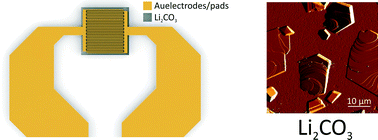Enhanced features of Li2CO3 sputtered thin films induced by thickness and annealing time†
Abstract
Li2CO3 sputtered films of 300 nm have been subjected to physical and electrochemical characterization methods to analyze the influence of annealing treatments at 600 °C for 2 h, 6 h, 12 h and 18 h on the microstructure, surface and conductivity. X-ray diffraction (XRD), Fourier transform infrared spectroscopy (FT-IR), atomic force microscopy (AFM) and electrochemical impedance spectroscopy (EIS) have been used for this purpose. XRD and FT-IR have illustrated the evolution of the microstructure with annealing time. AFM analysis has shown the growth of new Li2CO3 particles that increases with annealing time presenting a maximum diameter of 16.8 μm without compromising the continuity of the films. EIS measurements have described a fall in the activation energy of the Li2CO3 thin films presenting a minimum around 1.18 eV. The results concerning the activation energy of the films have shown an improvement compared to the results obtained previously for Li2CO3. These results serve to understand and optimize the behaviour of the Li2CO3 thin films in gas sensors, fuel cells or Li+ ion batteries.


 Please wait while we load your content...
Please wait while we load your content...